With power outages becoming common and electricity prices rising, people prefer using solar energy instead of electricity to charge their gear. Solar panels are the most critical component in the solar power system that converts solar power into usable electricity. However, there are multiple solar panels available on the market, making it hard for homeowners to choose the right one.
When you're in the market for solar panels, you'll come across two standard panel options: monocrystalline and polycrystalline. Though both solar panels convert the sun's energy into electricity, monocrystalline solar panels are more efficient and durable. That's why Jackery SolarSaga Solar Panels are made using uniform monocrystalline solar cells, making them highly efficient.
If you're wondering about the differences between monocrystalline vs. polycrystalline solar panels, this article is for you. In this ultimate guide, we will walk you through solar cell technologies in detail with their pros and cons and how to choose the best one.
What Is The Monocrystalline Solar Panel?
A monocrystalline solar panel comprises high-quality, single-crystal silicon cells.
As the cell is constituted of a single silicon crystal, there is more space for electrons to move for a better electricity flow. As a result, they are more efficient than their polycrystalline cell counterparts.
Additionally, they have an octagonal shape and uniform color, improving their overall look. Let us understand the monocrystalline solar panels based on their working principle, pros, and cons below.
Monocrystalline Solar Panel Working Principle

Now that you know the basics of mono solar panels, here is how they work.
- Monocrystalline solar panels work when the sun's energy falls on the upper surface.
- The cells absorb the energy to create an electrical field.
- This electrical field comprises two electrical ratings, mainly current and voltage. The combination helps in the generation of power, which is governed by P (power) = V (voltage) × I (current).
- The power generated by the solar panels can be directly used to power devices using an inverter or power station.
Monocrystalline Solar Panels Pros & Cons
Below are a few important pros and cons of monocrystalline solar panels you need to consider before buying.
Pros
- Monocrystalline solar panels have high-efficiency rates, generally around 15-20%.
- They are space-efficient, as they can produce more power per square foot than other types of solar panels.
- They are suitable for warm weather or low-light conditions.
- Since they use a single type of monocrystalline cells, they have the longest life compared to polycrystalline.
- Many people find the uniform shape and color aesthetically appealing, making them the first choice of buyers.
Cons
- Monocrystalline is a little expensive compared to polycrystalline solar panels.
Monocrystalline Solar Panel Appliances
Monocrystalline solar panels produce more energy on a small scale than poly solar panels. They can draw out the maximum amount of power even in low-light conditions. In addition, they've better heat tolerance, making them suitable for extreme heat conditions. Here are a few applications of monocrystalline solar panels.
- Monocrystalline cells generate between 40-130 watts, making them useful for higher-wattage appliances like microwave ovens, refrigerators, etc.
- The array of monocrystalline cells can charge rural homes and are a reliable home backup solution.
- When used as standalone panels, they are ideal for street lightning.
What Is The Polycrystalline Solar Panel?
Polycrystalline or multi-crystalline solar panels combine several non-uniform silicon crystals in a single PV cell. Several silicon fragments are melted to form wafers of polycrystalline solar panels.
As there are multiple silicon crystals used in manufacturing, there is less space for electrons to flow. Hence, they are less efficient. The main difference between monocrystalline vs. polycrystalline solar panels is that the latter have low heat tolerance, making them unsuitable for hot weather.
Furthermore, less silicon is wasted during the production of polycrystalline solar cells. Thus, these panels are more affordable and eco-friendly than monocrystalline solar panels.
Polycrystalline Solar Panel Working Principle
As these solar panels consist of multiple PV cells, their working principle differs slightly from monocrystalline cells.
- The photons from the sun's energy fall on the PN junction (a junction between P-type and N-type materials).
- It imparts energy to the electrons to enable an easy flow of electric current. The power generated is then used to charge power stations.
Note: The P-type materials are electron deficient, whereas N-type materials have an abundance of electrons. These two electrodes are connected to the PV cells.
Polycrystalline Solar Panel Pros & Cons
To understand the significant differences between mono and poly solar panels, it's worth noting the pros and cons of poly solar panels.
Pros
- Polycrystalline solar panels are affordable compared to monocrystalline solar panels as they are easier to make and use multiple, low-quality silicon cells.
- The manufacturing process is simple and requires fewer fossil fuels.
Cons
- They are less efficient due to low silicon purity.
- When exposed to high temperatures, they can be easily damaged.
- They may not last as long as monocrystalline panels.
- They are less aesthetically appealing.
Polycrystalline Solar Panel Appliances
Polycrystalline cells are suitable for areas that receive maximum sunlight. Here are a few applications of polycrystalline solar cells.
- Polycrystallinepanels are generally used in large solar farms to harness the sun's power and supply electricity to nearby areas.
- They are suitable for roof-mounted arrays.
- They are used in self-powered or standalone devices like traffic lights in off-grid households, remote areas, etc.
Monocrystalline Vs. Polycrystalline Solar Panels
The primary goal of solar panels is to convert solar energy into electricity. However, to make the most out of solar energy, you'll need to choose the best type of solar panels that are compatible with portable power stations.
Below are a few facts that will help you understand monocrystalline vs. polycrystalline solar panels.
- When comparing mono vs. poly solar panels,the former has a black color and high-efficiency rating.
- Polycrystalline solar panels are made of multiple silicon crystals and are blue in color. These panels are often less efficient and affordable.
- Monocrystalline solar panels are relatively more preferred compared to polycrystalline solar panels because of the advantages associated with them.
Here is how monocrystalline vs. polycrystalline solar panels stack against each other in a few critical areas.
|
Parameters |
Monocrystalline Solar Panels |
Polycrystalline Solar Panels |
|
Material |
Single Pure Silicon Crystal |
Different Silicon Fragments Molten Together |
|
Space Efficiency |
Efficient |
Less Efficient |
|
Conversion Efficiency |
15% to 20% |
13% to 16% |
|
Lifespan |
Minimum 25 Years |
Up to 25 Years |
|
Cost |
High |
Low |
|
Recyclability |
Yes |
Yes |
|
Temperature Coefficient |
-0.3% / c to -0.5% / c (High) |
-0.3% / c to -1% / c (Low) |
|
Appearance |
Uniform dark black squares with rounded edges |
Blue non-uniform squares with no rounded edges |
Monocrystalline Vs. Polycrystalline: Materials
Monocrystalline solar power panels are made of pure silicon crystals. Several octagonal-shaped wafers combine to form mono cells. They are made using half-cut technology, where the square-shaped solar cells are cut to produce twice the number of cells.
On the contrary, polycrystalline solar cells do not use a pure form of silicon. Instead, they are manufactured using silicon fragments. Therefore, the monocrystalline lasts longer and is more durable than the polycrystalline panels.
Monocrystalline Vs. Polycrystalline: Appearance
In terms of aesthetics, monocrystalline solar cells are superior to polycrystalline panels. The black hue and discreet look of the mono solar panels look aesthetically pleasing.
On the other hand, polycrystalline appears to have a blue hue and a non-uniform structure. Hence, they are less preferable for homeowners looking to purchase solar panels based on looks.
Monocrystalline Vs. Polycrystalline: Efficiency
In general, in poly vs. mono solar panels efficiency comparison, monocrystalline cells have a high-efficiency rate. This is because they are made from superior-grade silicone and offer minimal electron flow resistance.
On the other hand, polycrystalline solar cells have low efficiency due to reduced silicon purity. The non-uniform structure of the poly solar cells converts less sunlight into electricity than mono cells when placed in the same conditions.
Monocrystalline Vs. Polycrystalline: Lifespan
Understanding the lifespan of solar cells is incredibly important when buying solar panels
On the parameter of lifespan, both monocrystalline and polycrystalline panels will produce electricity for 25 years or more. However, the exact solar panel lifespan will depend on the brand and manufacturer.
Monocrystalline Vs. Polycrystalline: Cost
In simple words, monocrystalline solar panels are more expensive compared to poly solar cells. The difference in the silicon structure is why mono solar cells are more expensive than other solar panels.
Additionally, manufacturers follow a complex process to produce monocrystalline solar cells. That being said, they are priced higher.
Note: Even though monocrystalline solar panels are expensive, they offer a high return on investment due to their efficiency.
Monocrystalline Vs. Polycrystalline: Temperature Coefficient
In warm weather, mono solar cells deliver higher efficiency. This is because they have a high-temperature coefficient that reduces their output degradation as temperature rises.
On the other hand, polycrystalline solar cells have a low-temperature coefficient. If you're living in an area that receives more sunlight, consider purchasing monocrystalline solar cells.
Monocrystalline Vs. Polycrystalline: Applications
Monocrystalline is lighter, smaller, foldable, and portable in nature. For this reason, they are ideal for camping and other outdoor adventures.
In addition, mono solar panels are a reliable power backup solution. They are a flexible and highly efficient source of energy. Combined with portable solar generators, monocrystalline solar cells can charge all your small and large appliances when the grid is down.
The third common use of solar panels is their permanent setup on the residential roof. In this case, you can choose either mono or poly solar cells. Both solar panels can help you convert the sun's energy into electricity.
Understand the applications of mono vs. poly solar panels below.
Application Solar Panel Comparison
|
|
Best solar panel for rooftops |
Best solar panel for home backup |
Best solar panel for camping |
|
Monocrystalline Solar Panels |
✅ |
✅ |
✅ |
|
Polycrystalline Solar Panels |
✅ |
❌ |
❌ |
Which Solar Panel Is Best For You?

Going solar helps you save money and reduces your dependence on the electrical grid. However, your final choice of solar panel will determine how many benefits you can reap from solar power panels. Below we've listed a few essential factors one must consider while selecting solar panels for their needs.
- Space Constraints:If you're planning to choose solar panels for RVs, motor homes, etc., it's best to choose highly efficient solar panels. Buying monocrystalline solar panels can maximize the sunlight to electricity conversion, so you can charge portable power stations faster.
- Budget:Both mono and poly solar panels can help you generate electricity and save dollars in the long run. However, it's important to note the initial investment associated with the purchase. For instance, choose monocrystalline panels if you can pay more for efficiency to get high returns.
- Personal Preferences: Monocrystalline and polycrystalline solar panels tend to appear differently. If the aesthetic appeal of solar panels is essential to you, going with monocrystalline panels would be the ideal solution.
- Climate: As you know, monocrystalline solar panels have higher heat tolerance than polycrystalline panels; it's suitable for hotter climates as well as areas that receive less sunlight. On the contrary, polycrystalline panels work great when they get a high intensity of direct sunlight.
Remember, the right choice depends on the benefits each type of solar panel offers and your needs. If you want to choose a solar solution with low initial investment, consider polycrystalline panels. On the other hand, monocrystalline is the best choice if you want solar panels to be highly efficient, durable, and aesthetically pleasing.
Best Portable Solar Panels With Jackery
Jackery SolarSaga Solar Panels are one of the best ways to utilize the sun's power. Composed of monocrystalline solar cells, they have the highest efficiency of 25% in the industry. You can connect the solar panels to the Jackery Explorer Portable Power Station to charge all home appliances.

The solar panels help you generate solar power, while the lithium power station stores it. You can choose the Jackery Solar Generator for off-grid power or as a reliable power backup solution. The best part about the solar power solution is that it is portable. You can carry the solar generator for outdoor adventures, including but not limited to camping, RV trips, etc.
Below we have mentioned the most popular Jackery SolarSaga Solar Panels.
Jackery SolarSaga 500X Solar Panel
The Jackery SolarSaga 500X Solar Panels have a high power output to charge the portable power station faster. They are built with highly efficient monocrystalline silicon solar cells that can convert the maximum sunlight that falls on them into electricity. The solar panels can be folded for convenient storage and easy transportation, ensuring you can harness the power of sunlight anywhere.
Jackery SolarSaga 200W Solar Panel
Power the Jackery Explorer 2000 Plus using the six SolarSaga 200W solar panels in just 2 hours. The advanced solar cells provide an excellent conversion efficiency of up to 24.3%.
The practical carrying bag available with the solar panel makes it portable for easy transportation. Thanks to the IP68 waterproof rating, the solar panels can withstand harsh and wet weather.
Jackery SolarSaga 100W Solar Panel
The lightweight, foldable, and easy-carry handle of the Jackery SolarSaga 100W Solar Panels makes them an ideal choice for outdoor adventurers and power outages.
The multi-layered cell technology, ETFE-laminated case, pocket zippers, and IP68 water-resistant quality make them durable and long-lasting.
To fully use Jackery SolarSaga 100W Solar Panels, consider combining them with Jackery Explorer 300 Plus /500 / 1000 v2 / 1000 Plus Portable Power Station.
Jackery SolarSaga 80W Solar Panel
The upgraded and dual-sided solar panels can generate power from both sides. In addition, the extra-white glass of Jackery SolarSaga 80W Solar Panel boosts conversion rates. You can charge multiple appliances with the brand-new solar panels and Jackery Explorer Portable Power Station.
Made with industrial-grade photovoltaic materials, they have the highest efficiency of 25%. Another unique feature of solar panels is the innovative foldable design that makes storage and operation easy.
Jackery SolarSaga 40W Mini Solar Panels
The Jackery SolarSaga 40W Mini Solar Panels are portable and ultra-lightweight, so you can conveniently carry them anywhere. The four-fold design ensures you can fold and pack the solar panels into the backpack. It also features direct USB charging ports, so you can power two small appliances, such as a camera or phone, with solar panels.
Let us compare the Jackery SolarSaga Solar Panels in this table.
|
Products |
Compatible with |
Conversion Efficiency |
Input & Output Ports |
Specialty |
|
Jackery SolarSaga 500X Solar Panels |
Jackery Explorer 5000 Plus, Explorer 3000 Pro, and Explorer 1000 Plus |
25% |
— |
Built with TOPCON cells and is ideal for DIY photovoltaic setups. IP68-rated solar panels to improve the outdoor durability. Foldable and portable design ensures easy transportation and installation. |
|
Jackery SolarSaga 200W Solar Panel |
Jackery Explorer 5000 Plus, Explorer 3000 Pro, Explorer 2000 v2, Explorer 2000 Plus, Explorer 1000 Plus, Explorer 1000 v2, Explorer 600 Plus, Explorer 500, Explorer 300 Plus, and Explorer 240 v2, Explorer 1000 Pro (out of market), Explorer 1500 Pro (out of market), Explorer 2000 Pro (out of market) |
24.3% |
— |
Made of advanced solar cells that offer high conversion efficiency of up to 24.3%. The three kickstands and the recommended angle ensures optimum absorption of the sun’s energy into electricity. IP68 waterproof rating, ETFE-laminated case, and magnetic pads on the solar cells make the panels suitable for all weather conditions. |
|
Jackery SolarSaga 100W Solar Panel |
Jackery Explorer 5000 Plus, Explorer 3000 Pro, Explorer 2000 v2, Explorer 2000 Plus, Explorer 1500 (out of market), Explorer 1000 Plus, Explorer 1000 v2, Explorer 1000 (out of market), Explorer 600 Plus, Explorer 500, Explorer 300 Plus, Explorer 300 (out of market), Explorer 240 v2, Explorer 240 (out of market), and Explorer 100 Plus,
|
24.3% |
USB-A Output: 5V, 2.4A USB-C Output: 5V, 3A |
Multi-layered solar cell technology generates electricity and performs better than other conventional panels. The two output ports available help you charge small devices like smartphones directly. IP68 water-resistant, ETFE-laminated, and the unique light-trapping surface abilities of the solar panel grab more power and make them durable. |
|
Jackery SolarSaga 80W Solar Panel (Out of Market) |
All the Jackery power stations. |
25% |
— |
92% of the transmittance rate, and the upgraded solar panel boosts the conversion rate. IP68 waterproof and dustproof certified solar panels are suitable for all outdoor conditions. The unique corner design and the low iron full toughened glass add durability to the solar panels. |
|
Jackery SolarSaga 40W Solar Panels |
Explorer 600 Plus, Explorer 300 Plus, Explorer 240 v2, and Explorer 100 Plus |
23% |
USB-A Output: 5V⎓2.4A USB-C Output: 5V⎓3A |
Ultra-lightweight design that makes the solar panels ideal for on the go use. IP68 waterproof-rated design and verified through 8 IEC tests to withstand extreme conditions and temperatures. |
Monocrystalline Vs. Polycrystalline FAQs
In this monocrystalline vs. polycrystalline FAQs section, we will focus on some frequently asked questions about the differences between the two types of panels.
What is the difference between black and blue solar panels?
Blue and black solar panels differ depending on how they are manufactured. Black monocrystalline solar panels are composed of uniform and high-quality silicon crystals. Therefore, they absorb more sunlight and generate electricity than their blue counterparts.
Can you mix mono and poly solar panels?
Yes. There are a few ways that can help you mix mono and poly solar panels. The easiest way is to simply use string inverters for all the solar panels. Another way is to utilize micro-inverters on each solar panel to maximize insolation.
How to make full use of Jackery solar panels?
The Jackery SolarSaga Solar Panels are made of high-quality monocrystalline silicon crystals that make them highly efficient. In addition, the ETFE-laminated case ensures that the solar panels last for decades and help you save money in the long run.
If you want to use a solar panel fully, consider attaching it to the Jackery Explorer Portable Power Station. The combination will help you efficiently convert sunlight into electricity and ensure you can charge all your appliances anytime.
Final Thoughts
Different solar panel types produce varied amounts of electricity. It's crucial to weigh the pros and cons of each type before making your final purchase decision. You can draw your own comparison between monocrystalline vs. polycrystalline solar panels depending on your power needs and budget.
If you're a homeowner wanting to choose a reliable power source that works effectively for indoor and outdoor use, you can browse through Jackery SolarSaga Solar Panel models. The monocrystalline solar panels have the highest efficiency of 25%, which outperforms all other conventional panels.
Also, sign up for our newsletter and stay updated with the latest product news, deals, and promotions.






















































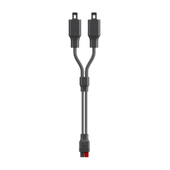














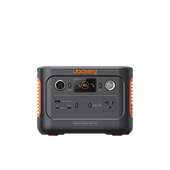

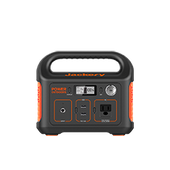
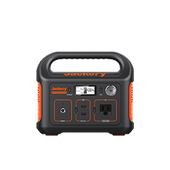







































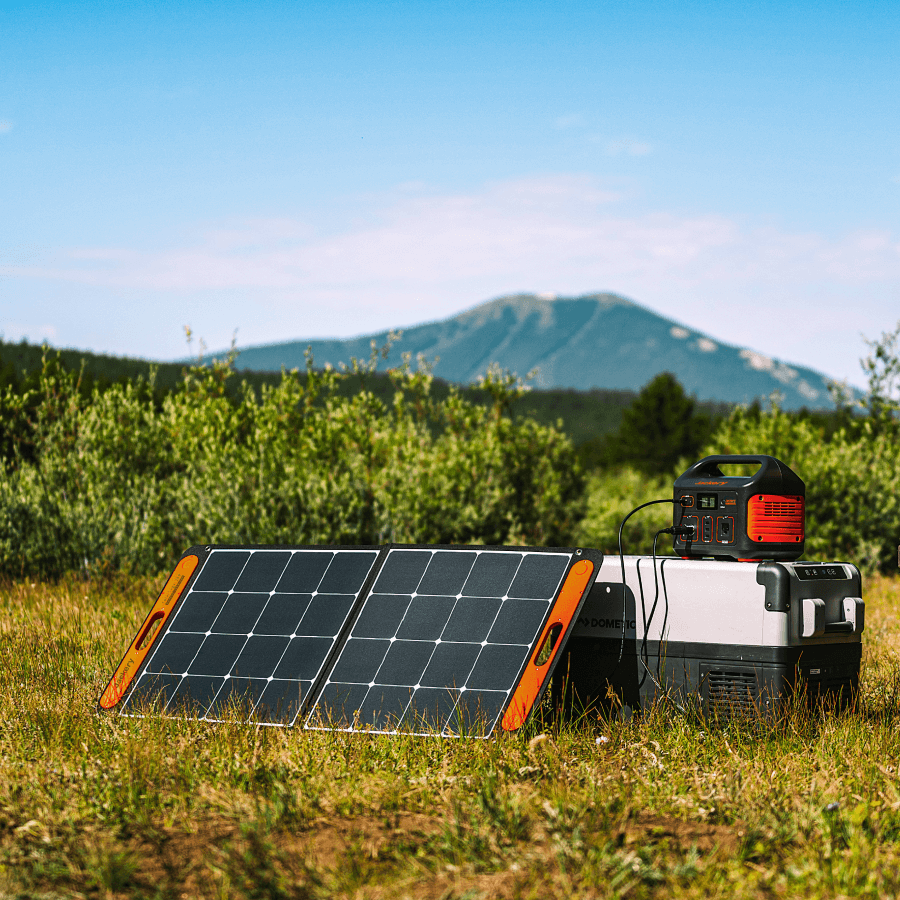


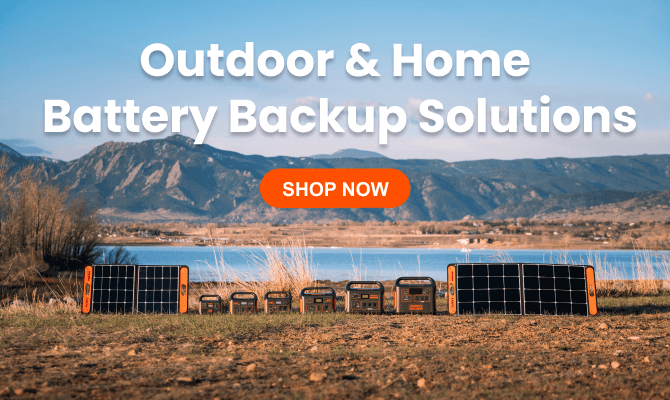
Leave a comment